Huy Phan
From Aesthetics to Human Preferences: Comparative Perspectives of Evaluating Text-to-Music Systems
Apr 30, 2025Abstract:Evaluating generative models remains a fundamental challenge, particularly when the goal is to reflect human preferences. In this paper, we use music generation as a case study to investigate the gap between automatic evaluation metrics and human preferences. We conduct comparative experiments across five state-of-the-art music generation approaches, assessing both perceptual quality and distributional similarity to human-composed music. Specifically, we evaluate synthesis music from various perceptual dimensions and examine reference-based metrics such as Mauve Audio Divergence (MAD) and Kernel Audio Distance (KAD). Our findings reveal significant inconsistencies across the different metrics, highlighting the limitation of the current evaluation practice. To support further research, we release a benchmark dataset comprising samples from multiple models. This study provides a broader perspective on the alignment of human preference in generative modeling, advocating for more human-centered evaluation strategies across domains.
Heterogeneous bimodal attention fusion for speech emotion recognition
Mar 09, 2025Abstract:Multi-modal emotion recognition in conversations is a challenging problem due to the complex and complementary interactions between different modalities. Audio and textual cues are particularly important for understanding emotions from a human perspective. Most existing studies focus on exploring interactions between audio and text modalities at the same representation level. However, a critical issue is often overlooked: the heterogeneous modality gap between low-level audio representations and high-level text representations. To address this problem, we propose a novel framework called Heterogeneous Bimodal Attention Fusion (HBAF) for multi-level multi-modal interaction in conversational emotion recognition. The proposed method comprises three key modules: the uni-modal representation module, the multi-modal fusion module, and the inter-modal contrastive learning module. The uni-modal representation module incorporates contextual content into low-level audio representations to bridge the heterogeneous multi-modal gap, enabling more effective fusion. The multi-modal fusion module uses dynamic bimodal attention and a dynamic gating mechanism to filter incorrect cross-modal relationships and fully exploit both intra-modal and inter-modal interactions. Finally, the inter-modal contrastive learning module captures complex absolute and relative interactions between audio and text modalities. Experiments on the MELD and IEMOCAP datasets demonstrate that the proposed HBAF method outperforms existing state-of-the-art baselines.
Bimodal Connection Attention Fusion for Speech Emotion Recognition
Mar 08, 2025Abstract:Multi-modal emotion recognition is challenging due to the difficulty of extracting features that capture subtle emotional differences. Understanding multi-modal interactions and connections is key to building effective bimodal speech emotion recognition systems. In this work, we propose Bimodal Connection Attention Fusion (BCAF) method, which includes three main modules: the interactive connection network, the bimodal attention network, and the correlative attention network. The interactive connection network uses an encoder-decoder architecture to model modality connections between audio and text while leveraging modality-specific features. The bimodal attention network enhances semantic complementation and exploits intra- and inter-modal interactions. The correlative attention network reduces cross-modal noise and captures correlations between audio and text. Experiments on the MELD and IEMOCAP datasets demonstrate that the proposed BCAF method outperforms existing state-of-the-art baselines.
LHGNN: Local-Higher Order Graph Neural Networks For Audio Classification and Tagging
Jan 07, 2025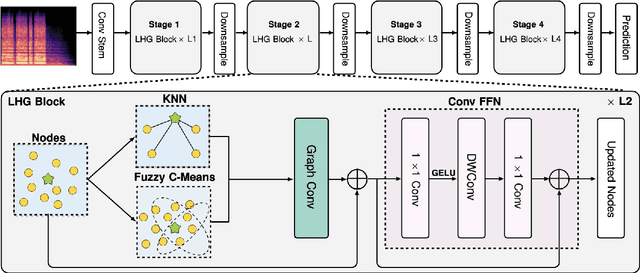
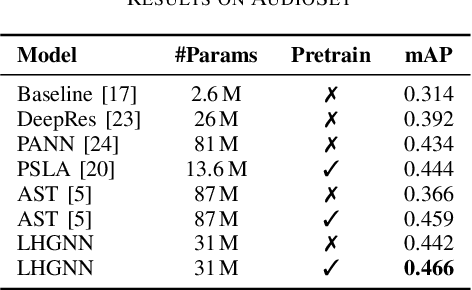

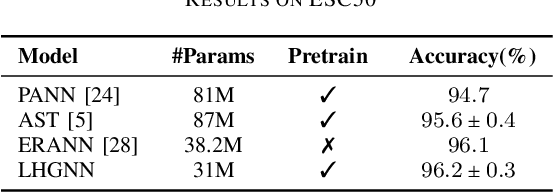
Abstract:Transformers have set new benchmarks in audio processing tasks, leveraging self-attention mechanisms to capture complex patterns and dependencies within audio data. However, their focus on pairwise interactions limits their ability to process the higher-order relations essential for identifying distinct audio objects. To address this limitation, this work introduces the Local- Higher Order Graph Neural Network (LHGNN), a graph based model that enhances feature understanding by integrating local neighbourhood information with higher-order data from Fuzzy C-Means clusters, thereby capturing a broader spectrum of audio relationships. Evaluation of the model on three publicly available audio datasets shows that it outperforms Transformer-based models across all benchmarks while operating with substantially fewer parameters. Moreover, LHGNN demonstrates a distinct advantage in scenarios lacking ImageNet pretraining, establishing its effectiveness and efficiency in environments where extensive pretraining data is unavailable.
AADNet: An End-to-End Deep Learning Model for Auditory Attention Decoding
Oct 16, 2024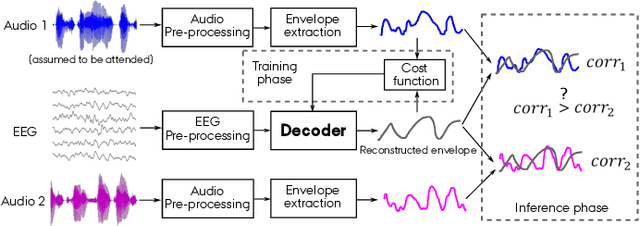
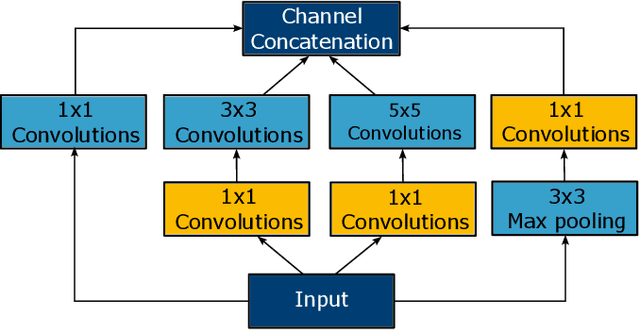
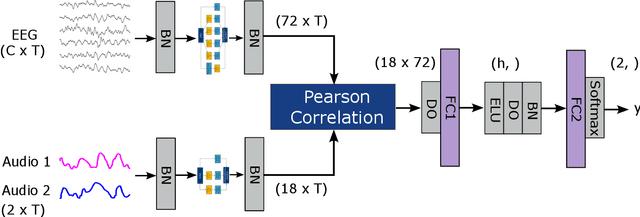
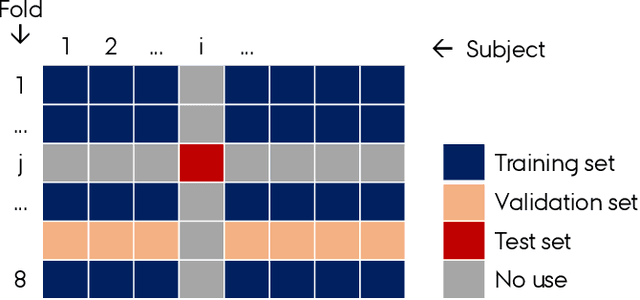
Abstract:Auditory attention decoding (AAD) is the process of identifying the attended speech in a multi-talker environment using brain signals, typically recorded through electroencephalography (EEG). Over the past decade, AAD has undergone continuous development, driven by its promising application in neuro-steered hearing devices. Most AAD algorithms are relying on the increase in neural entrainment to the envelope of attended speech, as compared to unattended speech, typically using a two-step approach. First, the algorithm predicts representations of the attended speech signal envelopes; second, it identifies the attended speech by finding the highest correlation between the predictions and the representations of the actual speech signals. In this study, we proposed a novel end-to-end neural network architecture, named AADNet, which combines these two stages into a direct approach to address the AAD problem. We compare the proposed network against the traditional approaches, including linear stimulus reconstruction, canonical correlation analysis, and an alternative non-linear stimulus reconstruction using two different datasets. AADNet shows a significant performance improvement for both subject-specific and subject-independent models. Notably, the average subject-independent classification accuracies from 56.1 % to 82.7 % with analysis window lengths ranging from 1 to 40 seconds, respectively, show a significantly improved ability to generalize to data from unseen subjects. These results highlight the potential of deep learning models for advancing AAD, with promising implications for future hearing aids, assistive devices, and clinical assessments.
MixNet: Joining Force of Classical and Modern Approaches Toward the Comprehensive Pipeline in Motor Imagery EEG Classification
Sep 06, 2024



Abstract:Recent advances in deep learning (DL) have significantly impacted motor imagery (MI)-based brain-computer interface (BCI) systems, enhancing the decoding of electroencephalography (EEG) signals. However, most studies struggle to identify discriminative patterns across subjects during MI tasks, limiting MI classification performance. In this article, we propose MixNet, a novel classification framework designed to overcome this limitation by utilizing spectral-spatial signals from MI data, along with a multitask learning architecture named MIN2Net, for classification. Here, the spectral-spatial signals are generated using the filter-bank common spatial patterns (FBCSPs) method on MI data. Since the multitask learning architecture is used for the classification task, the learning in each task may exhibit different generalization rates and potential overfitting across tasks. To address this issue, we implement adaptive gradient blending, simultaneously regulating multiple loss weights and adjusting the learning pace for each task based on its generalization/overfitting tendencies. Experimental results on six benchmark data sets of different data sizes demonstrate that MixNet consistently outperforms all state-of-the-art algorithms in subject-dependent and -independent settings. Finally, the low-density EEG MI classification results show that MixNet outperforms all state-of-the-art algorithms, offering promising implications for Internet of Thing (IoT) applications, such as lightweight and portable EEG wearable devices based on low-density montages.
* Supplementary materials and source codes are available on-line at https://github.com/Max-Phairot-A/MixNet
Data-Centric Human Preference Optimization with Rationales
Jul 19, 2024



Abstract:Reinforcement learning from human feedback plays a crucial role in aligning language models towards human preferences, traditionally represented through comparisons between pairs or sets of responses within a given context. While many studies have enhanced algorithmic techniques to optimize learning from such data, this work shifts focus to improving preference learning through a data-centric approach. Specifically, we propose enriching existing preference datasets with machine-generated rationales that explain the reasons behind choices. We develop a simple and principled framework to augment current preference learning methods with rationale information. Our comprehensive analysis highlights how rationales enhance learning efficiency. Extensive experiments reveal that rationale-enriched preference learning offers multiple advantages: it improves data efficiency, accelerates convergence to higher-performing models, and reduces verbosity bias and hallucination. Furthermore, this framework is versatile enough to integrate with various preference optimization algorithms. Overall, our findings highlight the potential of re-imagining data design for preference learning, demonstrating that even freely available machine-generated rationales can significantly boost performance across multiple dimensions. The code repository is available at https: //github.com/reds-lab/preference-learning-with-rationales
1st Place Solution to Odyssey Emotion Recognition Challenge Task1: Tackling Class Imbalance Problem
May 30, 2024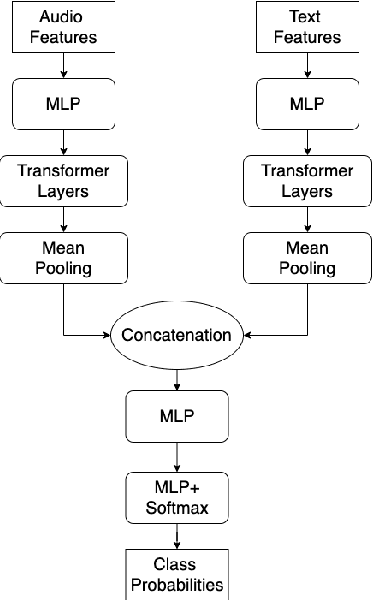



Abstract:Speech emotion recognition is a challenging classification task with natural emotional speech, especially when the distribution of emotion types is imbalanced in the training and test data. In this case, it is more difficult for a model to learn to separate minority classes, resulting in those sometimes being ignored or frequently misclassified. Previous work has utilised class weighted loss for training, but problems remain as it sometimes causes over-fitting for minor classes or under-fitting for major classes. This paper presents the system developed by a multi-site team for the participation in the Odyssey 2024 Emotion Recognition Challenge Track-1. The challenge data has the aforementioned properties and therefore the presented systems aimed to tackle these issues, by introducing focal loss in optimisation when applying class weighted loss. Specifically, the focal loss is further weighted by prior-based class weights. Experimental results show that combining these two approaches brings better overall performance, by sacrificing performance on major classes. The system further employs a majority voting strategy to combine the outputs of an ensemble of 7 models. The models are trained independently, using different acoustic features and loss functions - with the aim to have different properties for different data. Hence these models show different performance preferences on major classes and minor classes. The ensemble system output obtained the best performance in the challenge, ranking top-1 among 68 submissions. It also outperformed all single models in our set. On the Odyssey 2024 Emotion Recognition Challenge Task-1 data the system obtained a Macro-F1 score of 35.69% and an accuracy of 37.32%.
Mind the Domain Gap: a Systematic Analysis on Bioacoustic Sound Event Detection
Mar 27, 2024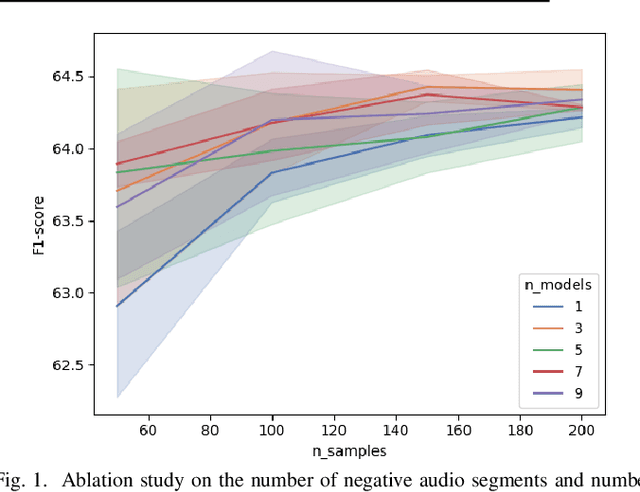
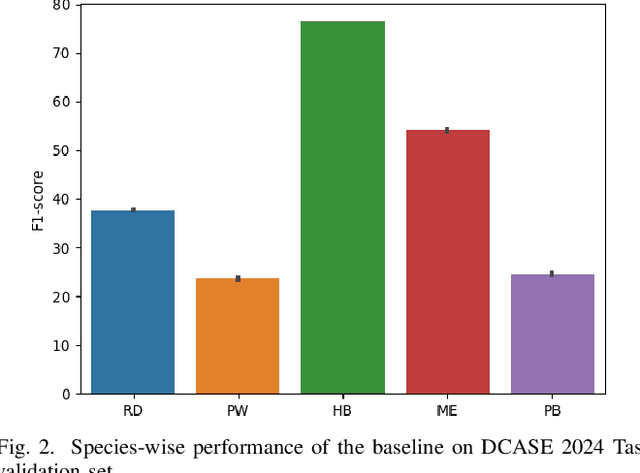


Abstract:Detecting the presence of animal vocalisations in nature is essential to study animal populations and their behaviors. A recent development in the field is the introduction of the task known as few-shot bioacoustic sound event detection, which aims to train a versatile animal sound detector using only a small set of audio samples. Previous efforts in this area have utilized different architectures and data augmentation techniques to enhance model performance. However, these approaches have not fully bridged the domain gap between source and target distributions, limiting their applicability in real-world scenarios. In this work, we introduce an new dataset designed to augment the diversity and breadth of classes available for few-shot bioacoustic event detection, building on the foundations of our previous datasets. To establish a robust baseline system tailored for the DCASE 2024 Task 5 challenge, we delve into an array of acoustic features and adopt negative hard sampling as our primary domain adaptation strategy. This approach, chosen in alignment with the challenge's guidelines that necessitate the independent treatment of each audio file, sidesteps the use of transductive learning to ensure compliance while aiming to enhance the system's adaptability to domain shifts. Our experiments show that the proposed baseline system achieves a better performance compared with the vanilla prototypical network. The findings also confirm the effectiveness of each domain adaptation method by ablating different components within the networks. This highlights the potential to improve few-shot bioacoustic sound event detection by further reducing the impact of domain shift.
WavCraft: Audio Editing and Generation with Natural Language Prompts
Mar 15, 2024



Abstract:We introduce WavCraft, a collective system that leverages large language models (LLMs) to connect diverse task-specific models for audio content creation and editing. Specifically, WavCraft describes the content of raw sound materials in natural language and prompts the LLM conditioned on audio descriptions and users' requests. WavCraft leverages the in-context learning ability of the LLM to decomposes users' instructions into several tasks and tackle each task collaboratively with audio expert modules. Through task decomposition along with a set of task-specific models, WavCraft follows the input instruction to create or edit audio content with more details and rationales, facilitating users' control. In addition, WavCraft is able to cooperate with users via dialogue interaction and even produce the audio content without explicit user commands. Experiments demonstrate that WavCraft yields a better performance than existing methods, especially when adjusting the local regions of audio clips. Moreover, WavCraft can follow complex instructions to edit and even create audio content on the top of input recordings, facilitating audio producers in a broader range of applications. Our implementation and demos are available at https://github.com/JinhuaLiang/WavCraft.
 Add to Chrome
Add to Chrome Add to Firefox
Add to Firefox Add to Edge
Add to Edge